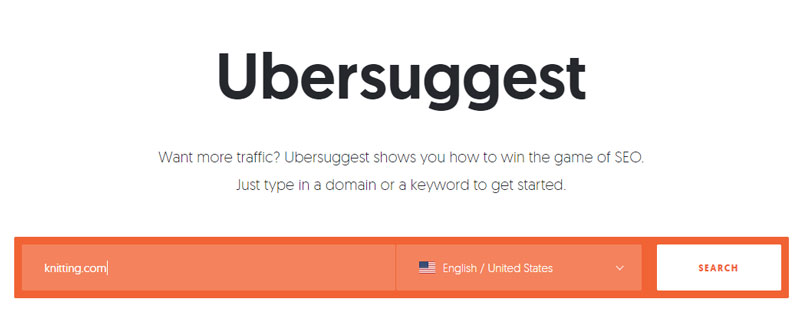
When learning how to do SEO keyword research, all of the tips, tricks, and ‘how-to’ articles can be totally overwhelming – especially for those just getting started.
Many of the SEO tools look like they belong to the New York Stock Exchange. Not to mention all of the technical-sounding terms and strategies mentioned.
Long-tail, head search terms, CTR, domain score…
This high barrier to entry makes it easy to give up keyword research altogether and just make articles at random and try to eventually strike gold on Pinterest or Google.
Here’s the problem though, if you don’t do keyword research you’re wasting your SEO efforts on creating content that is either:
- Not being searched for.
- Too competitive to easily rank for (especially if you’re a beginner).
When you are putting a lot of effort into something and you’re seeing zero results, it’s easy to get discouraged. This is the last thing you want as a new blogger or website creator.
That’s why keyword research is the most important first step to creating content for your blog. Especially if you’re relying on Google as a core traffic source.
Follow along to learn how to easily create your first SEO keyword strategy. This guide is very beginner-friendly and doesn’t require investing in any expensive tools.
And the good news is, keyword research isn’t nearly as complicated as you might think. In fact, a solid keyword strategy can be boiled down to meeting three key objectives…
What Makes a Keyword a Good Fit for Your Blog?
It’s simple really – a good keyword meets the following three objectives:
-
- The keyword needs to be relevant to your blog. Maybe I could rank #1 for “space hotdogs”, but would it really help my business?
- The keyword can’t be too difficult to rank for. If lots of other people are creating great content for a search term, it’s going to be hard for a beginning blog to rank.
- The keyword needs to get enough searches to be worth your time. How many searches are enough? This entirely depends on how mature your blog/website already is. For brand new blogs, 50 might be worth it as you build Google credibility. For more mature blogs anything less than 500 might be a waste of your time.
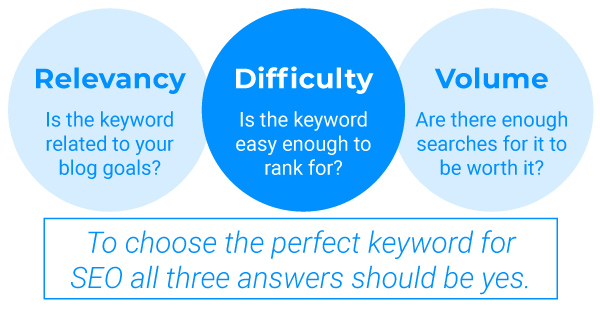
Let’s dig a little deeper into each of those three criteria, starting with relevancy.
And remember, keyword research is just as much about helping you find content worth creating as it is finding content not worth creating.
Keyword Relevancy
Before you invest any time creating content around a keyword you think you want to rank for, make sure you search for the keyword into Google.
Do pages currently ranking in the top 3 spots on Google contain content similar to what you plan on creating for that keyword?
If the content isn’t similar at all, then trying to rank for that keyword is probably not worth your time.
- Google is smart enough to tell if your content is related to the intent behind what a searcher is looking for.
- If I search for “Tough Mudder Near Me” vs “Tough Mudder Training,” Google shows drastically different results. That’s because the search engine is always trying to provide the most relevant search results.
- Google can also tell if your overall website niche contains content similar to what you’re trying to rank for.
- For example, if you’re creating a website about knitting, but have a random blog post about tacos – it’s less likely to rank than if your entire website were about tacos.
Also, just because you can rank for a keyword doesn’t mean you should. Ask yourself if gaining traffic for a search term really matches your blogging goals.
If you’re primarily a knitting blog, do you really want people coming to your blog to learn about tacos? Probably not.
I’d much rather have 10 people visit my blog who are engaged, rather than 1,000 who are there by accident.
That’s why it’s always important to make relevancy a priority as you choose keywords.
Keyword Difficulty
The hard truth is, there are just some keywords you will not be able to rank for. Especially if you’re a new blogger in a popular niche. That’s why, before you go “all-in” on a keyword, you need to double-check that it’s possible to rank for.
In general, shorter 1-3 word searches are going to be significantly harder for beginners to rank for than 4+ word keywords. If you’re creating a knitting blog from scratch, for example, it’s going to be virtually impossible for you to rank #1 on Google for the term “knitting.”
However, after doing some quick keyword research, I find that a more ‘long-tail’ term like “how to bind off knitting” is a much more achievable term to tank for.
Free keyword research tools like Ubersuggest and Google Keyword Planner (we’ll talk about how to use these later) will give you a general score on how hard a keyword is to rank for as well.
Keyword Volume
In my day job as a digital marketer, I do a lot of SEO consulting. I’ll often get questions like, “why aren’t we ranking for this keyword? We’re not showing up, but our competitors are – how can we show up too?”
The first thing I do when I get a question like this is, do some quick keyword research to see if this is even a search term worth ranking for.
While you might think that a keyword is popular on Google, it might turn out that it gets zero monthly searches – and you’re the only one actually ‘Googling’ the term.
So, why would we waste our efforts trying to rank for a keyword that no one is searching for?
There are always exceptions, but I personally wouldn’t spend time trying to rank for a keyword that gets fewer than 50 searches a month.
This means even if you rank #1 for a search term getting 10 monthly searches, your website will probably only get about 3 clicks.
How to Get Started with Keyword Research
The first thing you need to decide is what type of content you want to rank for.
You probably already have the main topic or niche for your website, but you should also choose three main categories and find keywords relating to each of those categories.
This is a strategy that helps show Google that you’re relevant to these main topics.
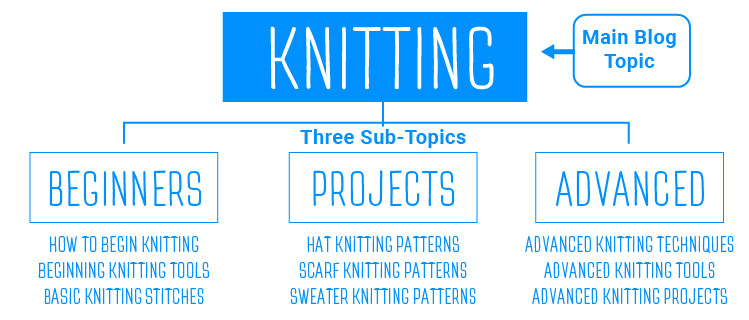
But, as you choose your keywords make sure your list is distinct. Creating blog posts and pages with overlapping keywords will cancel out your efforts.
Once you have your categories in mind, I recommend a list of 5-10 keywords per topic.
This means you’ll end up with a list of 15-30 distinct keywords to build a content strategy from.
But, to choose these keywords, you’ll need to use some keyword tools.
Free Keyword Research Tools
Now that you understand the basics of what it takes to rank on search engines, it’s time to get started with using keyword research tools.
For the purpose of keyword research, you want a tool that gives you new ideas for keywords, while also telling you how competitive the keyword is, and how often it gets searched.
Here are a few of the top tools you can use for free:
- Ubersuggest (Free)
- Google Keyword Planner (Free but built with ads in mind)
- Keyword Sheeter (Free – no competitiveness or search volume info)
- SEMRush (Freemium – can only see top keywords)
I think the best free keyword research tool for beginners is Ubersuggest.
Not only is it free, but it gives you search volume and competitiveness information. And, you get unlimited searches. Plus, it’s simple to use.
However, to get all the features you will have to sign-in with Google to get all the features. After you sign up you can expect to join the Ubersuggest mailing list.
This tool also isn’t going to be quite as powerful or accurate as a premium tool like SEMRush, but it’s still very good and super beginner-friendly.
How to Use Ubersuggest
Important Update: As of February, 2020 Neil Patel has converted UberSuggest to a paid tool. The free version is no longer a powerful keyword research tool.
I recommend using SEMRush as the free results are much more accurate.Look for an update to this post with instructions on how to use SEMRush in the next few weeks!
On UberSuggest (and most other keyword tools) you can do two basic things to help you find great keywords to target.
- Enter a broad keyword and get more realistic target keyword ideas related to that topic.
- Enter a competitor’s domain and get a list of keywords they are ranking for.
Let’s start with option 1 by entering a very broad topic keyword related to your niche.
Step 1: Enter a Broad Search Term
We’ll continue using our ‘knitting’ example…

Once you enter the keyword you’ll instantly get all kinds of information related to the “knitting” keyword.
For example, you’ll see that as the temperature gets cooler around October (for most of us in the USA) the number of searches peaks.
As the weather starts to warm up, the searches go down. You’ll also get some very basic demographic information.
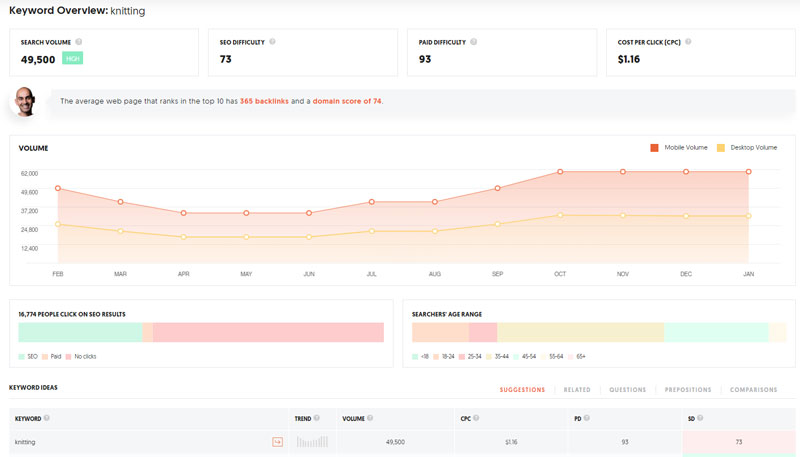
As you scroll down, you get to the meat of what you’re looking for. Keyword ideas.
Step 2: View All Keyword Ideas
You’ll initially see a list of only 7 keywords. This isn’t much to work with. So, make sure to hit the ‘View All Keyword Ideas’ button.
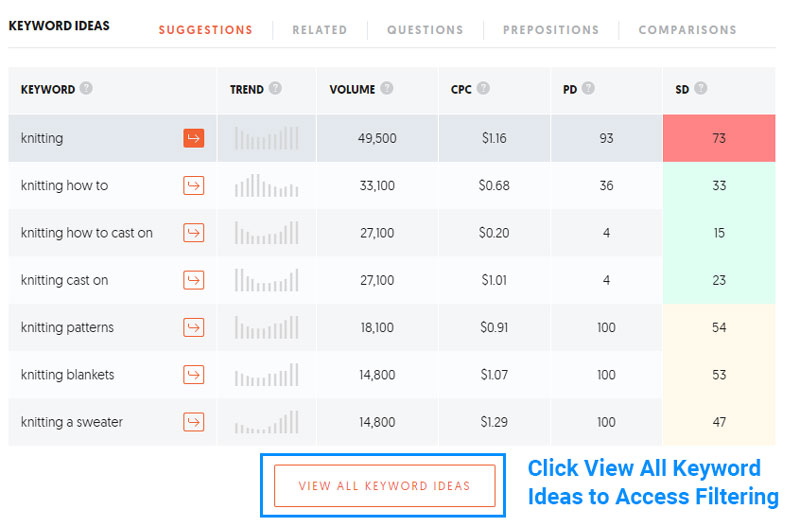
Now, you won’t be able to rank for many of these keywords because they’re too competitive.
Instead of sifting through each keyword line by line, automate the process by using the filtering feature.
Note that to use the filtering tool, you’ll need to allow access to your Google account.
Step 3: Filter the Keyword Ideas
I like to use the filtering tool to find keywords that are in a targeted range of both competitiveness and search volume.
I usually start with a minimum search volume of 50 and max SEO competitiveness of 20.
You might need to adjust a bit depending on your topic, but I find it’s a pretty good place to start at finding easier to rank for keywords.
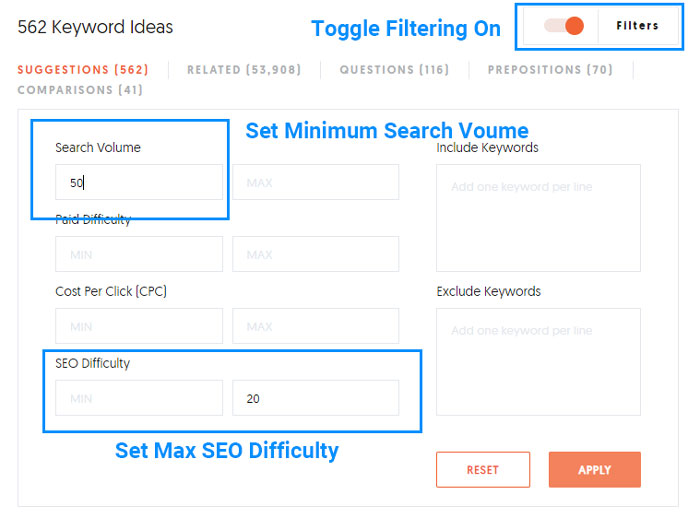
Without the filtering tool, Ubersuggest will also show lots of keywords that get 0 monthly searches. These keywords definitely are worth your time so it’s easier to filter them out.
After hitting apply, you’ll see that a new list of keywords.
Step 4: Disregard any Non-Relevant Keywords
I want to use the filtered ‘knitting’ list as a perfect example of a non-relevant keyword.
While almost every keyword is perfectly relevant to a knitting blog, one stands out as non-relevant.
“The Knitting Factory Spokane” is not something you’d want to target as a knitting blog.
When you Google this search term you’ll find results for an adults-only concert chain. Not relevant at all to knitting sweaters.
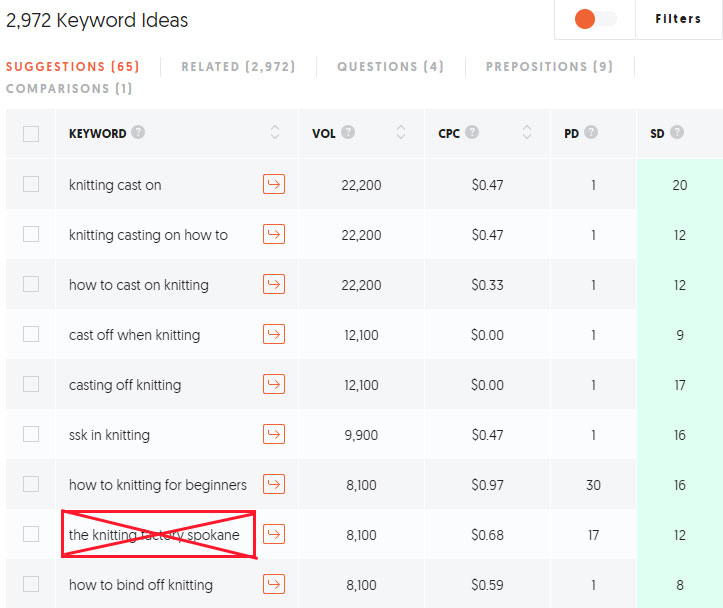
So remember, before you start making content for a keyword, give it a Google and make sure it’s relevant to your blog.
Step 5: Repeat this Step for Other Broad Keywords
Continue this step with other keyword ideas.
For the knitting example, I’d drill down into the topic a bit more to get ideas for each of my three main blog categories:
- Beginner Knitting
- Knitting Projects
- Advanced Knitting
Remember, the idea is to have 5-10 keywords for each of your blog’s main categories. Use these categories as bases for your search.
If you find that no one is searching for the terms you type in, then you probably need to niche up and go for broader search terms
Step 6: Repeat this Step for Competing Domains
Have a knitting blog rival you want to borrow some traffic from? Try entering their domain into Ubersuggest.
This new Ubersuggest feature will tell you the top keywords a domain ranks for. Analyze the list and use filtering to see if there are any opportunities for you.
Choose a Diverse List of Keywords
When you’re beginning especially, it’s important to try and get some quick wins.
To do this, you need to create a diverse list of keywords.
This means picking both long-tail keywords with less search volume but easier competitiveness and more competitive (usually shorter) terms that have a higher volume.
If you’re a brand new blogger with zero SEO success, I’d start with a mix of 70% long-tail low competitive keywords, 20% medium competitive, and 10% high competitive.
Start creating content for the easier-to-rank for keywords so you can see the results of SEO early. This will help you gain confidence and momentum as you create more and more content for SEO.
If you start with more competitive terms first, it will be easier to get discouraged and give up.
How to Use Keywords in Your Blog Posts
Once you have a list of target keywords, how do you use them?
Well, you’ll want to make sure to incorporate the keywords into your blog content.
For each keyword, you’ll need to create a new blog post. Don’t worry, this is a long-term strategy so you don’t need to create all the pages for your keywords at once.
Where to Place Your Keywords in Blog Post
The number one thing to remember is, at the end of the day you’re writing for a human, not a Google search robot.
So while you do want to use your keyword in your content, don’t overdo it. Make it readable and entertaining.
In general, I recommend including your target keyword in the:
- Blog Title (ideally toward the beginning) – not only is this good for Google but if someone searches for a term, they must see it immediately on the page they clicked on. This improves the time spent on your blog which is also a positive SEO signal.
- URL/Slug – The actual link to your blog post should contain your target keyword.
- H1 tag – for WordPress, the H1 tag is often the same as the blog title. (by the way, each blog post/page should only have one H1 tag.)
- H2/H3/H4/H5/H6 tags – you should have several H2 tags per blog post to help break up content and make it more skimmable. Incorporate your target keyword into at least one H2 tag, but don’t overdo it
- Meta Description – This doesn’t directly impact your SEO, but if a key term in the search listing show up, Google automatically bolds it. This improves the chances of someone clicking on your search listing.
- First Image name – I like to include the target keyword in the first image on my blog post, as well as in the image alternative description. Make sure the image has to do with your target keyword. Most bloggers skip this step, so it’s important to include it as part of your SEO strategy to get an edge.
How else can you reinforce your target keyword
Creating content around your target keyword isn’t just about plugging in your keyword in specific spots on your blog post. It’s also about making sure you answering the intent behind the search.
One way to do this is by looking at current top-ranking pages to see how they create content that matches the keyword.
Do not copy what your competitor doing, but instead create content that covers your target keyword even better.
You can also use tools that find related keywords and make sure to cover these topics as well.
This ensures that your blog post is as comprehensive at covering a topic as possible.
Free tools like LSIGraph and Answer the Public are great for finding related keywords.
Here’s an example using the keyword ‘knitting’ on Answer The Public.
All you have to do is type in your target keyword and the tool spits out tons of questions that can help you create a more comprehensive piece of content around a target keyword.
It can also spark some new content ideas for your blog.

Also, don’t forget about Google’s AutoComplete. Trying typing your target keyword into Google and seeing what terms show up before you hit search.
These terms are seen as relevant to your keyword in Google’s eyes, so covering them in your blog post will help the page seem more relevant.
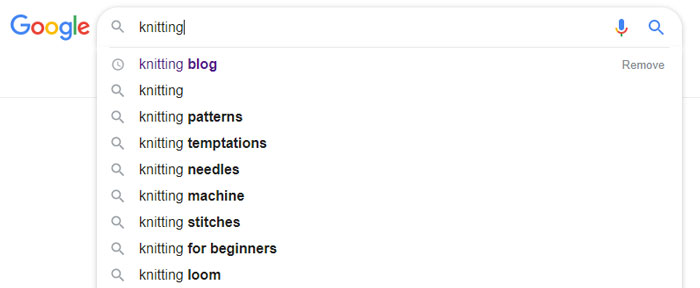
Don’t forget Internal Linking
As Google crawls your website, it makes note of which pages are being linked to internally.
And, when you link to a page using your target keyword in the anchor text, that signals to Google that the page is the most important page on your website for that keyword.
For that reason, it’s very important to use internal linking throughout your site. Especially for pages that you’re actively trying to rank for.
Make sure to use your target keyword in the anchor text.
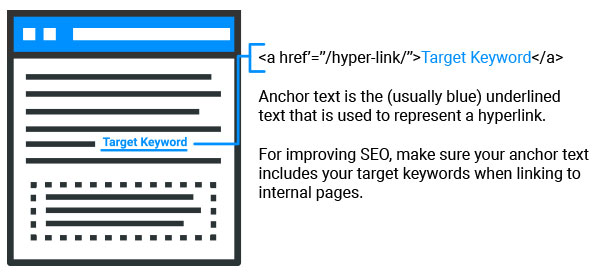
This signals to Google that the page you’re linking to is important for that target keyword.
Keyword Research for Existing Search Terms
Ranking for new keywords is super important, but don’t forget to improve your existing search terms.
If you haven’t already, make sure to set up Google Analytics and Google Search Console.
Google Search Console is especially important for seeing how your keywords are performing on the Google search engine.
Using the performance tab, you can see all of the keywords (or queries) your website showed up for in Google in a certain time period.
This will help you track how well your SEO efforts are paying off.
- Are your target keywords showing up in Google?
- What is their average position?
- What is their clickthrough rate?
- Using the compare feature, are you performing better than last month on Google?
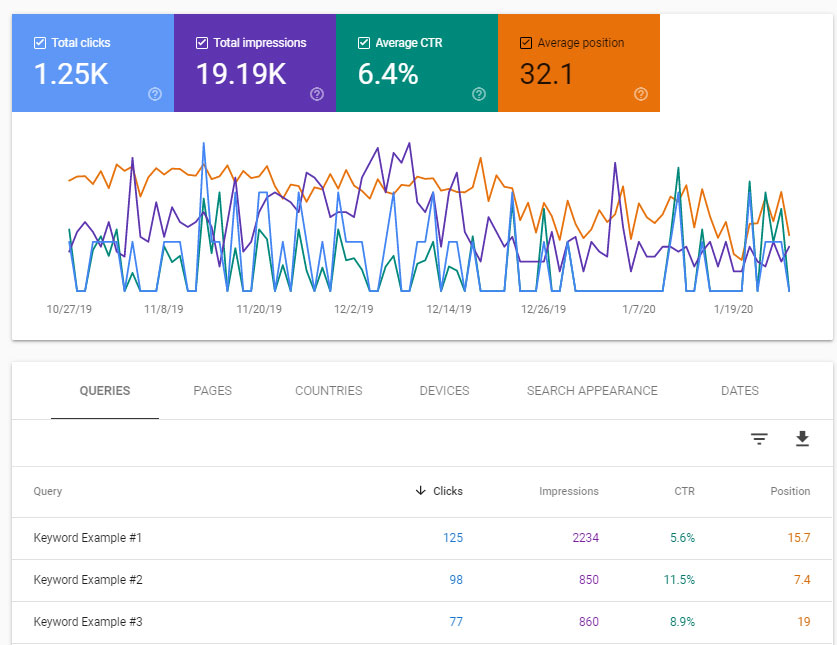
Search Console might also help you discover new keywords you weren’t even trying to rank for. If this happens, you can start working to improve the pages that are ranking by accident and help them climb even higher on Google.
If you’re serious about SEO, Google Search Console is basically required. It’s more important than Google Analytics.
Next Steps for Improving SEO
Want to learn even more about SEO? Check out my blog post What is SEO? A Non-Technical Beginner’s Guide for Bloggers.
Also, make sure you have professional analytics set up for your blog to track all of your SEO success.
Have you ever set up a keyword strategy? How did it pay off? I’d love to hear about it in the comments below.
